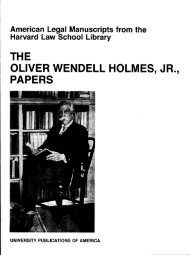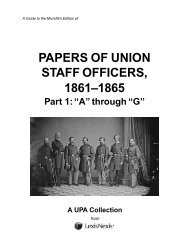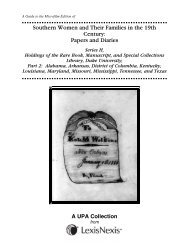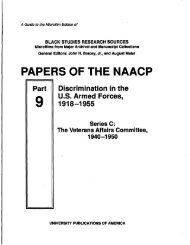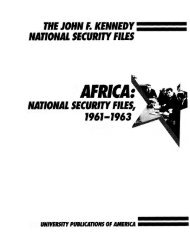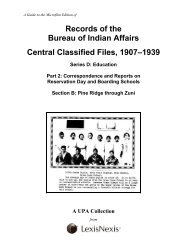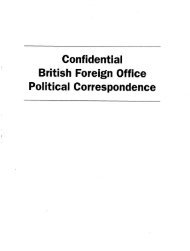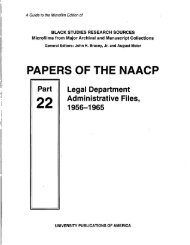guide - ProQuest
guide - ProQuest
guide - ProQuest
You also want an ePaper? Increase the reach of your titles
YUMPU automatically turns print PDFs into web optimized ePapers that Google loves.
Since that time, Nixon and/or his key aides have brought<br />
additional suits attempting to prevent the opening of<br />
documents in these controversial Special Files. In the interim,<br />
archivists have reduced the volume of the Nixon Special Files<br />
by six percent; legal representatives of the former President<br />
and members of his administration have withdrawn another<br />
ten percent. Although users can request mandatory reviews<br />
of both sets of winnowed material, the historical record of the<br />
Nixon administration has at least temporarily been diminish-<br />
ed. In the event that some of these documents are reviewed<br />
once again by federal archivists, the former President can still<br />
challenge their release through the courts. Thus the specter<br />
of protracted litigation still hangs over these contested pages.<br />
Subsequent to the 1979 "negotiated agreement," NARA<br />
drafted six sets of regulations under which both the most sen-<br />
sitive materials, along with the most commonplace ones from<br />
the voluminous Nixon White House Central Files, would be<br />
processed. Previous sets had been revised or dropped because<br />
of congressional or legal actions. Before obtaining approval<br />
in 1986 from the Office of Management and Budget (OMB)<br />
to publish the sixth set in the Federal Register, the National<br />
Archives was given a Justice Department memorandum, at-<br />
tached to but not published with these regulations, that une-<br />
quivocally stated that Nixon could still invoke executive<br />
privilege over these documents, and that President Ronald<br />
Reagan or any future sitting President would have to honor<br />
the claim without reviewing the merits. Litigation on this<br />
memorandum was still pending in March 1988.<br />
The 4,000 hours of tape recordings pose even thornier ar-<br />
chival and access problems. It would take a single person almost<br />
two years of non-stop listening for eight hours a day just to<br />
hear all of the tapes without taking time to review or analyze<br />
them. Although NARA has basically completed processing<br />
the tapes and prepared a 27,000-page finding aid for resear-<br />
chers, lawyers for Nixon and some of his top advisers claim<br />
that untold numbers of violations of the personal privacy of<br />
individuals remain. They argue that the review process agreed<br />
to in the 1979 "negotiated agreement" has not been proven<br />
feasible with respect to those controversial secret tapings, and<br />
that, therefore, they should be reviewed again using stricter<br />
privacy standards.<br />
In the unlikely event that no further legal barriers are<br />
encountered, sometime during the 1990s the National Archives<br />
intends to open those recorded conversations that the Water-<br />
gate special prosecutor requested (not all of these were used<br />
as evidence and, hence, were made public in various court cases<br />
after 1974). After these initial eighty hours of special prose-<br />
cutor tapes are opened, NARA will follow its regulations and<br />
• release additional segments, similar to the manner in which<br />
the first Special Files documents began to be released sequen-<br />
tially in 1987. This means that all persons mentioned in the<br />
recordings who have requested that they be notified in advance<br />
will be, in the event they would want to file charges against<br />
the release of specific conversations. Thus, even with the Tape<br />
Survey Log, researchers face many delays and obstacles before<br />
they will be able to analyze and interpret this unique docu-<br />
mentary source•the White House tapes.<br />
Other unusual characteristics of the Nixon presidential<br />
papers involve the subject matter of the records released to date<br />
and contained in various parts of the microfiche editions pub-<br />
lished by University Publications of America. The first is that<br />
most of the obvious abuse-of-power documents had already<br />
been presented as evidence and made public when various<br />
Nixon aides and their staff members were tried in the last half<br />
Nixon Papers, Part 5. H. R. Haldeman Notes<br />
of the 1970s. Consequently, journalists, but not historians, were<br />
generally disappointed and confused by the release of the first<br />
records from the White House Central Files, because they did<br />
not contain sensational revelations. The initial 1.5 million pages<br />
of documents opened in December 1986 focused on domestic<br />
subject files ranging from welfare and environmental issues<br />
to Supreme Court appointments and desegregation of schools.<br />
These files are of enormous historic, if not headline, value to<br />
aid in understanding the formulation of the major domestic<br />
policies of the one-and-one-half Nixon administrations.<br />
Secondly, those papers released in May and July 1987 con-<br />
sisted of 1.5 million documents that make up the total volume<br />
of the Special Files. These were purported to be of particular<br />
importance to the abuse-of-power question, but have not yet<br />
revealed any significant information about the Watergate break-<br />
in or its cover-up that had not already been presented as evi-<br />
dence in court cases in the 1970s. The first opening in May,<br />
for example, included five major file groups of papers relating<br />
to the work in the White House of John Dean, Harry Dent,<br />
John Ehrlichman, Egil Krogh, and Gordon Strachan.<br />
The second opening in May contained 267,500 papers ac-<br />
tually created or seen by Richard Nixon during his tenure in<br />
office. These included both the President's Office Files, with<br />
notations in Nixon's handwriting, and "Personal Files" for<br />
1969-1974, in addition to segments of the papers of Desmond<br />
J. Barker, Jr. (2,500 pages); Patrick J. Buchanan (22,500 pages);<br />
Dwight L. Chapin (35,000 pages); Peter M. Flanigan (12,500<br />
pages); David R. Gergen (2,500 pages); General Alexander M.<br />
Haig, Jr. (40,000 pages); Kenneth L. Khachigian (25,000 pages);<br />
Herbert G. Klein (5,000 pages); Tom C. Korologos (2,500<br />
pages); Frederic V. Malek (2,500 pages); John A. Scali (5,000<br />
pages); Gerald L. Warren (2,500 pages); David R. Young, Jr.<br />
(22,500 pages); and Ronald L. Ziegler (42,500 pages).<br />
At the July 1987 opening, 823,450 more papers from the<br />
Special Files were released, consisting of 353,600 pages created<br />
or maintained by Nixon's Chief of Staff H. R. Haldeman and<br />
108,800 pages by Special Counsel Charles Colson. Other seg-<br />
ments opened at the same time included: John R. Brown III<br />
(2,400 pages); Stephen B. Bull (4,000 pages); Alexander P. But-<br />
terfield (10,000 pages); J. Fred Buzhardt (4,000 pages); Michael<br />
J. Farrell (1,600 pages); Edwin L. Harper (800 pages); David<br />
C. Hoopes (25,000 pages); W. Richard Howard (5,000 pages);<br />
Peter E. Millspaugh (1,600 pages); Terrence O'Donnell (1,600<br />
pages); Peter G. Peterson (2,400 pages); Geoffrey C. Shepard<br />
(2,400 pages); Hugh W. Sloan, Jr. (1,610 pages); Richard C.<br />
Tufaro (2,000 pages); J. Bruce Whelihan (8,400 pages); and<br />
David G. Wilson (1,600 pages).<br />
Thirdly, these first historic openings of the Nixon presiden-<br />
tial papers are but the tip of the iceberg for researching this<br />
controversial and important administration, especially its best<br />
known activity outside of Watergate, namely, foreign policy.<br />
Unfortunately, national security considerations have prevented<br />
any systematic declassification of materials pertaining to<br />
Nixon's record in the field of foreign affairs. Despite the publici-<br />
ty it receives, the Freedom of Information Act is not an ade-<br />
quate historical tool for obtaining the necessary aggregate data<br />
to document the decision-making processes involved in<br />
formulating U.S. diplomacy for Nixon's or any other recent<br />
administration. Moreover, the National Security Council,<br />
responsible for declassification of most foreign policy<br />
documents, has not yet concentrated on the Nixon years. To<br />
make matters worse for those interested in studying the<br />
diplomacy of the United States from 1969 through 1974, crucial<br />
foreign policy advisers such as Henry Kissinger and Alexander



